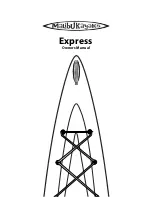
10
11
EN
SVB Spezialversand für Yacht- & Bootszubehör 2016
SVB Spezialversand für Yacht- & Bootszubehör 2016
2.8 Storage
• To retain the vessel’s luster for as long as possible, store it in a dry, airy place
with no direct sunlight.
• When storing the dinghy, make sure that no heavy objects that could damage it
are placed on top of it.
• If the boat is not going to be used for a long period of time, protect it with
a tarpaulin. Weathering, air pollution and UV radiation can lead to the faster
aging of the vessel’s material. This is particularly true in areas with strong
sunlight.
2.9 Air pressure information
• Inflate the dinghy with the included pump or a foot pump. If you are using
an electric pump, complete the pumping process with a foot pump, to ensure
uniform air pressure.
• While either inflating or deflating, it is important to maintain a balance in air
pressure between the different chambers. This helps to avoid any damage to
the chamber partitions.
• The following air pressure values should be adhered to:
- Normal air pressure for chambers: 0.25 bar
- Normal air pressure for AEROTEND floors: 0.8 bar
- Normal pressure for DOLPHIN keels: 0.35 bar
• A dinghy that has been inflated for 2-3 days can lose pressure. According to
ISO 6185, an inflatable vessel’s air pressure can drop by 20% within 24 hours of
inflation.
Check the pressure in each of the air chambers and inflate them if necessary.
• Depending on the climate and operating conditions, the unit’s air pressure
must be monitored, in order to make sure that it remains constant.
Strong sunlight increases the air pressure significantly, while cooler conditions
decrease air pressure significantly.
• If the dinghy is inflated at sea level and then transported to higher altitudes,
you must decrease the air pressure to avoid overpressure.
3. Safety Instructions
Attention! Pay attention to your safety and that of your children –
Be careful in offshore winds and currents!
It is every skipper’s responsibility to inform themselves on the operation of the
vessel and all of the equipment on board. It is also necessary for them to add
to this knowledge by adhering to all of the corresponding rules and regulations
at sea. Pay attention to all local legislations and legalities before operating any
vessel!
Applicable legal requirements may change or vary due to the following factors:
• The operational area of the vessel
• The requirements set by the local authorities
• The boat’s purpose of use
• The time of day
• Operating conditions
• Size, speed, boat type (engine power, paddles, etc.)
As a skipper, you are responsible for the following legal regulations and skills:
• Each passenger on board must wear appropriate clothing and have a lifejacket
or similar life-saving equipment at their disposal.
• Ensure that all standard safety equipment is on board. Such equipment should
include paddles/oars and a pump. Additional safety equipment is also
necessary.
• A person who is under the influence of drugs or alcohol is not able to navigate
a boat.
• Weight must be evenly distributed. If your boat isn’t heavily loaded and it’s
operated by a motor, avoid sudden acceleration. Not having complete control
of the vessel can lead to stability and operational problems.
• When operating a motorboat alone, don’t sit on one side or too far back. Avoid
accelerating the boat too fast, in order to reduce the risk of falling overboard.
Once the passengers are on board, they should hold on to the safety line, in
order to avoid falling overboard.
• The max. carrying capacity and max. engine power must not be exceeded.
• Outboard motors are dangerous and unexpected movements caused by your
motor-powered dinghy can cause serious injury. Never operate a vessel with
an inappropriate motor!
• Keep clear of swimmers and make sure that you do not approach them with
the engine running.
• Special attention should be given to the wind and tides, whereby changes can
also affect fuel consumption.
• Before driving in to unknown areas, check with the authorities about any
possible risks or danger zones.



























